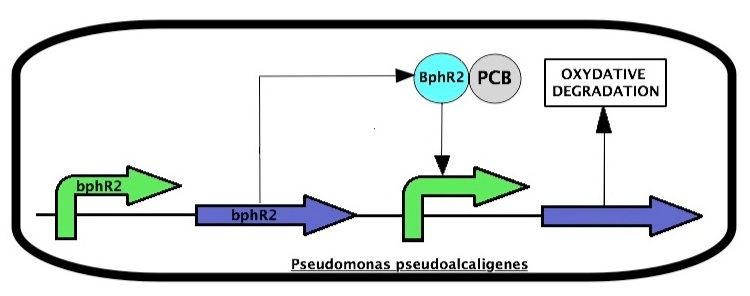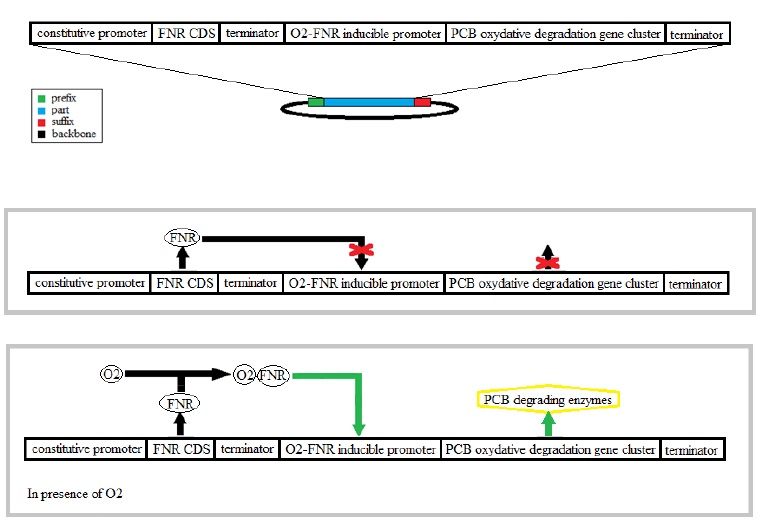Team:Paris Saclay/Project
From 2013.igem.org
Detection and degradation of PCB system in Escherichia coli
Since the second half of the XXth century, scientists are fully aware that some bacterial species living in media with high concentration of PCBs are able to degrade PCBs into pyruvate and acetyl-CoA which are then easily metabolized by these organisms.
These bacterial species structure in biofilm with regions that have variable concentrations of oxygen, high at the surface and decreasing with depth. Bacteria living in this habitat have, in most cases, different degradation pathways, which are aerobic or anaerobic depending on their spatial disposition in the biofilm.
Bacteria in aerobic environment use PCB oxidative degradation pathways; those in anaerobic condition degrade PCBs via reductive dechlorination pathways. None of the bacteria seems to use both pathways.
The reductive dechlorination reduces the number of chlorines of high chlorinated PCBs. The dechlorinated PCBs can be further degraded by an oxidative degradation which is efficient only with low chlorinated PCBs. That’s may explain why these different species coexist in biofilms.
Our goal in this project is to desing an organism able to i) detect PCB and then ii)
employ a sequential degradation of the PCB using both combined pathways.
For our experiences, we used bacteria present in nature that are able to detect and degrade the
PCBs, namely [http://en.wikipedia.org/wiki/Burkholderia_xenovorans Burkholderia xenovorans], [http://www.ncbi.nlm.nih.gov/pubmed/22843571Pseudomonas pseudoalcaligenes KF 707] and
[http://en.wikipedia.org/wiki/RhodococcusRhodococcus jostii RHA1].
Construction of a system to detect the presence of PCBs
Italic textPseudomonas pseudoalcaligenesItalic text has a system that regulates the oxidative degradation of PCBs. It is based on two regulatory proteins, BphR2 and BphR1 coded by the bphR2 and bphR1 genes, respectively. BphR2 is a transcriptional activator that is stimulated by PCBs. PCBs induce a BphR2 conformational modification which results in the expression of genes coding for the enzymes responsible for the PCB oxidative degradation.
It also induces the expression of bphR1.
The BphR1 protein detects HO-PCBs, metabolites derived from PCBs that are produced by PCB oxidative degrations. In presence of OH-PCBs, BphR1 induces his own transcription and also of the downstream genes from its operon. These later genes contribute to further degrade the PCBs.
For the project, we will use the bphR2 gene and the bphR1 promoter. We will place the bphR2 coding sequence under a constitutive promoter. We will also construct a transcriptional fusion between the bphR1 promoter with the lacZ gene coding for the β-galactosidase enzyme. The amount of β-galactosidase can be easily monitored by a chemical reaction using Xgal. With this system, the β-galactosidase activity will dependent on the bphR1 promoter expression. Since the bphR1 promoter is controlled the activated BphR2 by PCBs, the β-galactosidase activity will be correlated with the presence of PCBs.
Combination of the aerobic and anaerobic PCB degradation pathways
The bacterium E. coli has an aerobic and an anaerobic metabolism that will be used to combine of the two PCB degradation pathways. The switch between the aerobic and an anaerobic metabolism is partly regulated the transcriptional regulator FNR. This protein is directly affected by the presence of oxygen which modifies its conformation.
The reductive dechlorination pathway is not well characterized only an enzyme, a dehalogenase, is mentioned as contributing to this pathway. In these anaerobic conditions the chlorine takes the place of the oxygen as the electron acceptor. That’s why we have chosen an activator FNR in presence of oxygen in order to activate the oxidative degradation.
Article writing by Eric
 "
"


